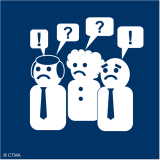A CEO and his management team were recently engaged in a “strategy session”. Like so many in our current economy, he was concerned about limited funds and declining revenues, and so he was searching for ways to cut costs.
 Sharing some of his ideas, he told his management team:
“We need to be
making cuts in staff, training, service-levels, and product quality”
Sharing some of his ideas, he told his management team:
“We need to be
making cuts in staff, training, service-levels, and product quality”
“Hold on a minute!” said one of his managers, “what about customer experience?”
“Good idea, we could probably cut some costs out of that too!” replied the CEO.
“No, that’s not what I meant!” said the manager, sounding somewhat exasperated. “What I meant was, if we cut costs out of staff, training, service-levels and product quality, it’ll have a seriously negative impact on customer experience!”
The CEO’s eyes narrowed for a minute, then looked up, shrugged, and replied somewhat scornfully, “Well, who benefits from better customer experiences anyway?”
Perhaps you’ve witnessed the same sort of conversation recently. From many reports in the news it seems that cost-cutting, at the expense of customer experiences, has become alarmingly popular. So, I though it might be timely to reflect on that CEO’s question, because he’s clearly not alone. Here are some of the things I’d suggest in response to his question.
“Who benefits from better customer experiences anyway?”
Well, the short answer is:
- Your customers
- Your staff
- Your managers and leadership
- Your business
- Your business owners and shareholders
So, let’s take a closer look at how each of these groups may benefit from better customer experiences, but as we look through the details, consider the opposite too. Consider how each group may suffer if customer experiences decline. Consider also how much this unnecessary burden might cost your organisation.
Your Customers
I’m sure we all agree that customers benefit from better customer experiences. But let’s consider how they benefit, and the value that benefit may bring.
- Happy, satisfied customers enjoy their interactions and find it easier to do business with you
- Happy, satisfied customers have a lower level of anxiety and stress doing business with you
- Happy, satisfied customers appreciate and value your products and services more
As a result, happy, satisfied customers are much more likely to choose to come to your business the next time they need one of the products or services you provide.
Your Staff
What about your staff? How might they benefit from better customer experiences?
- Happy, satisfied customers are easier to serve
- Happy, satisfied customers have fewer complaints for your staff to handle, and when satisfied customers do have a complaint, they can be less confrontational
- Dealing with happy, satisfied customers leaves staff with more time available to get more things done and more things done right
- Dealing with happy, satisfied customers is less stressful for staff and they enjoy their work more
As a result, happy, satisfied employees are more likely to be engaged in their work, more productive, make fewer mistakes, stay with your business longer, and recommend you to others.
Your Managers and Leadership
What about your managers and leadership team? How might they benefit from better customer experiences?
- Happy, satisfied customers lead to happy, satisfied employees
- Happy, satisfied employees are easier to manage
- Happy, satisfied employees are more productive
- Happy, satisfied employees are more engaged in doing a great job
- Happy, satisfied employees have fewer problems or grievances to be handled
As a result, your managers can focus more time on creative, inspirational leadership, and looking for ways to make your organisation even more successful.
Your business
How might better customer experiences benefit the business as a whole? Well, happy satisfied customers, and happy satisfied staff, and more creative and inspirational leadership can provide your business with:
- More revenue from returning happy, satisfied customers
- More revenue from the referrals made by happy, satisfied customers
- Increased market-share from happy, satisfied customers choosing your business instead of its competitors
- Reduced recruitment costs resulting from a lower staff turnover and more employee job referrals
- Reduced induction and training costs resulting from a lower staff turnover
- Improved profitability resulting from a reduced cost-of-sale, reduced turnover costs, reduced training costs, and improved productivity and engagement
- And in some industries, reduced costs arising from the potential risk of regulatory intervention being introduced to protect consumer interests
As a result, with increased revenues, productivity, engagement, creative leadership and reduced unnecessary costs, the business becomes more profitable and is free to focus on growth and value-creation instead of decline and cost-reduction.
Your business-owners and shareholders
What about your business owners and shareholders? How might they benefit from better customer experiences, revenue growth and more profit?
- Increasing business valuation
- Improved dividends
- And in the public sector, improved public outcomes
As a result, your business owners and shareholders become more confident in the organisation’s leadership, and more secure in their current and potential future investment.
Why do so many organisations ignore this?
 So, with such a clear relationship between better customer
experiences and improved outcomes for
everyone involved, why do so many
organisations seem to ignore this?
So, with such a clear relationship between better customer
experiences and improved outcomes for
everyone involved, why do so many
organisations seem to ignore this?
Why is it that this CEO, and the senior leadership of many other organisations, seem to be oblivious to the benefits of better customer experiences, and the wasted costs and wasted opportunities that arise from poor customer experiences, and when times get tough, they resort to cost-cutting strategies that may undermine customer experiences?
I believe the main reason is because many organisations
fail to measure customer experience performance in financial terms.
Many boardroom metrics, like revenue, profit, overhead, and operating costs can be easily expressed in “dollars”. So, even big decisions are sometimes made using fairly straightforward arithmetic.
(Profit = Revenue – Cost)
So, if the profit number starts to get too small, an effort is made to make the cost number smaller, to make the profit number bigger again.
The problem is that many organisations today measure customer experience performance in terms of a simple percentage, index, or score. Although each of these metrics may look well on a trend chart, none of them can be easily plugged into the formula.
So, boardroom decisions often overlook the potential impact that a declining customer experience performance may have on their bottom line.
What are the real risks?
 Many businesses and public services are
rightly looking for ways
to reduce wasted costs.
Many businesses and public services are
rightly looking for ways
to reduce wasted costs.
But a good customer experience is NOT a “wasted cost” and bad customer experiences can be very costly. A failure to identify and fix poor customer experiences is a costly wasted opportunity.
From research we’ve conducted in multiple industries we’ve learned that a poor customer experience is one of the key reasons businesses lose customers and fail to get positive referrals – often placing 25% of their revenue at-risk.
From our public sector research, we’ve found that a poor customer experience can have just as costly an impact by reducing cooperation and compliance, increasing the need for monitoring and penalties, undermining the organisation’s reputation, and compromising desired public outcomes.
In “good times”, the severity of these risks can be hidden behind ample sources of investment and revenue, and large margins. But when times get tough, they can make the difference between success and failure.
Key action point
 When times
get tough, don’t make cost-cutting your primary defensive strategy.
When times
get tough, don’t make cost-cutting your primary defensive strategy.
Firstly, be certain that you’ve exhausted your opportunities to improve your bottom line through better customer experiences. Don’t “kill the goose” that “lays your golden eggs” without first checking so see if your biggest wasted costs are from poor customer experiences.
Otherwise you may be undermining the interests of your customers, your employees, your managers and leadership, your organisation, its business owners and shareholders.
And, when times are good, this same practice will make you even more successful!
Give customer experience strategic relevance by using metrics that clearly link customer experience performance to your organisation’s outcome objectives (e.g. the dollar). And use actionable diagnostic measurement, and enterprise-wide accountability, to drive improvement, innovation and value creation.
 Then the topic of “customer
experience” can gain genuine traction in the boardroom, and take its
essential place in the strategic decision-making process. The
conversation can then move from
downward-spiralling cost-reduction to
value-creation and
growth.
Then the topic of “customer
experience” can gain genuine traction in the boardroom, and take its
essential place in the strategic decision-making process. The
conversation can then move from
downward-spiralling cost-reduction to
value-creation and
growth.
That’s why so much of the work we do with businesses and the public sector is to help them establish a baseline of outcomes-at-risk, estimate the cost of poor customer experiences, identify and prioritise the problems that customers experience in terms of their biggest impact on their bottom-line and estimate the potential return-on-investment from improvements.
Now, more than ever, organisations must build an adaptive customer-driven enterprise that can remove wasted costs and barriers to business, seek out and fix the problems that customers and staff experience, excel at service delivery, and outperform their competition.
© CTMA New Zealand Ltd.
Let’s talk
If you’re looking for opportunities to improve your bottom line through better customer experiences I’d love to hear from you.
Please
get in touch and we’ll
schedule a call or Zoom Meeting so we can learn more about your
organisation and your current customer experience challenges, and help
you move the conversation from potential downward-spiralling
cost-reductions to value-creation and
growth.![]()
About the author: Paul Linnell
 Paul Linnell is a customer experience and service quality
improvement champion, working internationally with senior managers
and their teams to help them achieve business success, reduce risk
and build customer loyalty and advocacy by taking actions to improve
customer experiences. Paul specialises in the design and deployment
of customer experience measurement, service quality improvement,
complaints handling and preventive analysis programmes. Industries
he has worked with include, Automotive, Consumer electronics,
Consumer goods, Electricity & Gas retail, Financial services,
Information technology, Local Government and Public Sector, Media /
Publishing, Passenger travel (Rail, Air and Sea), Pharmaceuticals
and Telecommunication. Paul has worked with clients and presented on
these subject at conferences and corporate events in the UK, Europe,
North America, the Middle East, Australia and New Zealand.
Originally from the UK and now based in New Zealand, he continues to
serve clients globally.
Paul Linnell is a customer experience and service quality
improvement champion, working internationally with senior managers
and their teams to help them achieve business success, reduce risk
and build customer loyalty and advocacy by taking actions to improve
customer experiences. Paul specialises in the design and deployment
of customer experience measurement, service quality improvement,
complaints handling and preventive analysis programmes. Industries
he has worked with include, Automotive, Consumer electronics,
Consumer goods, Electricity & Gas retail, Financial services,
Information technology, Local Government and Public Sector, Media /
Publishing, Passenger travel (Rail, Air and Sea), Pharmaceuticals
and Telecommunication. Paul has worked with clients and presented on
these subject at conferences and corporate events in the UK, Europe,
North America, the Middle East, Australia and New Zealand.
Originally from the UK and now based in New Zealand, he continues to
serve clients globally.

.png)